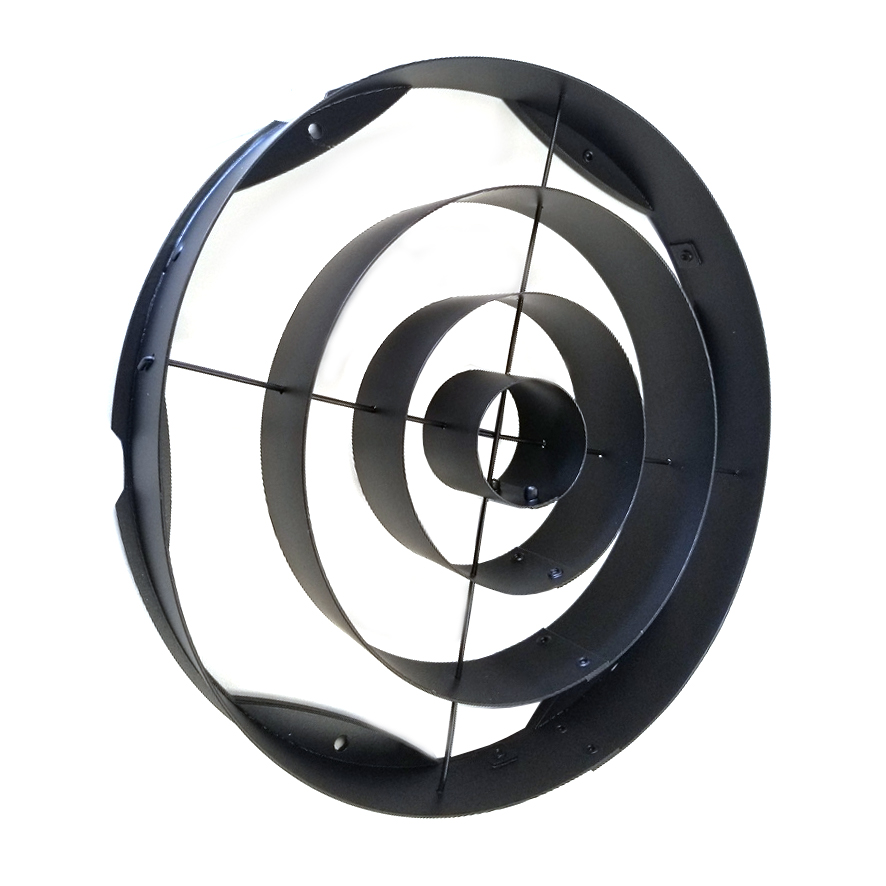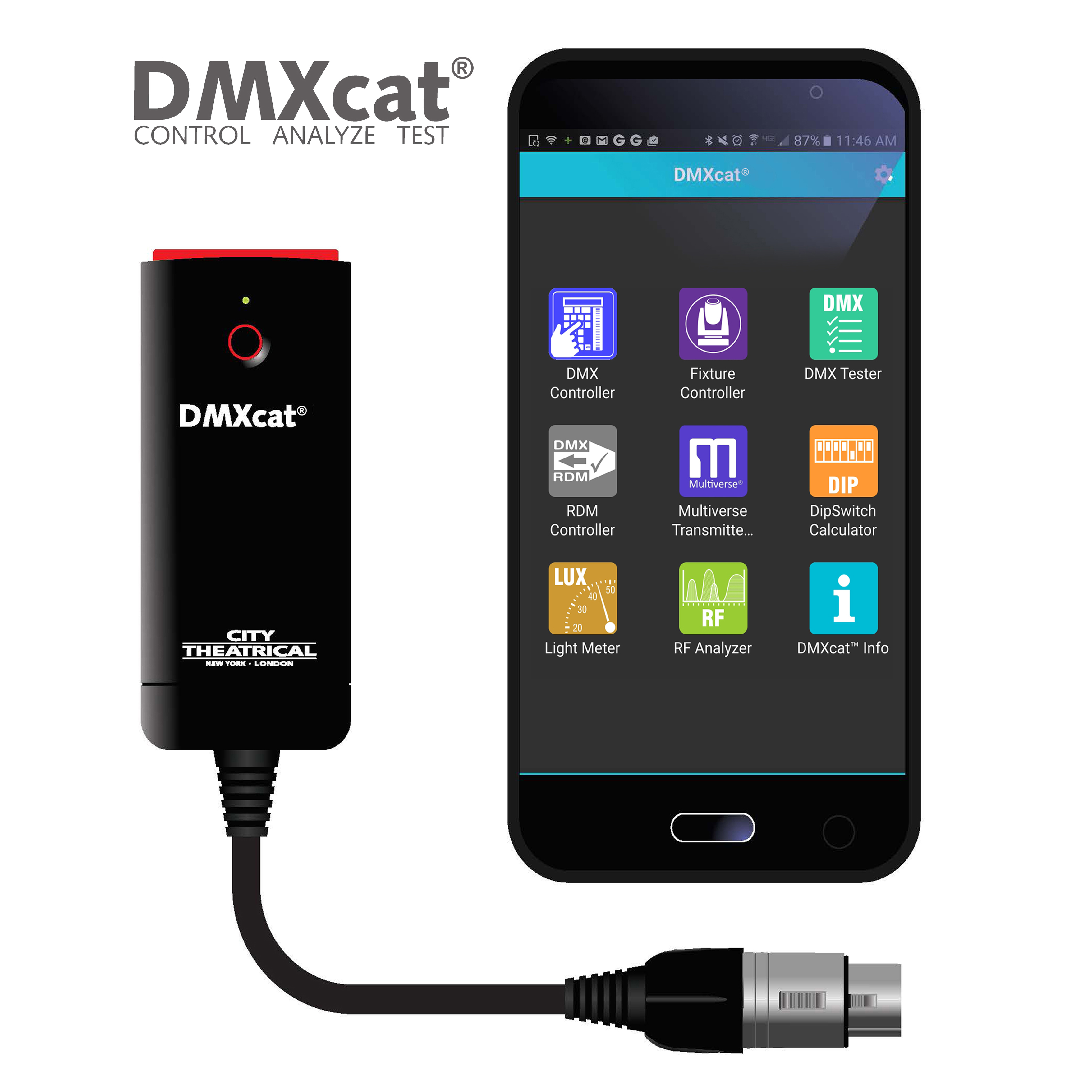Interview with Cheyenne Mendoza, VPAC
City Theatrical talked to the Technical Director of Vilar Performing Arts Center (VPAC), Cheyenne Mendoza, to find out about how he got started in the world of lighting for live performance, and what it is like working at the VPAC in Beaver Creek, Colorado, USA.
City Theatrical Interview with VPAC Technical Director Cheyenne Mendoza
Cheyenne Mendoza is a Technical Director for the Vilar Performing Arts Center (VPAC), which is uniquely located slopeside at one of the world's premier winter sports resorts, Beaver Creek, Colorado, USA. City Theatrical had the opportunity to talk with Cheyenne backstage during "Spring Skiing" season to find out more about his career, what it's like to light shows in the Rocky Mountains, his favorite performances at the VPAC, and why he prefers to use City Theatrical's GLP beam control accessories with his GLP X5 lighting fixtures, as well as other unique lighting accessories.
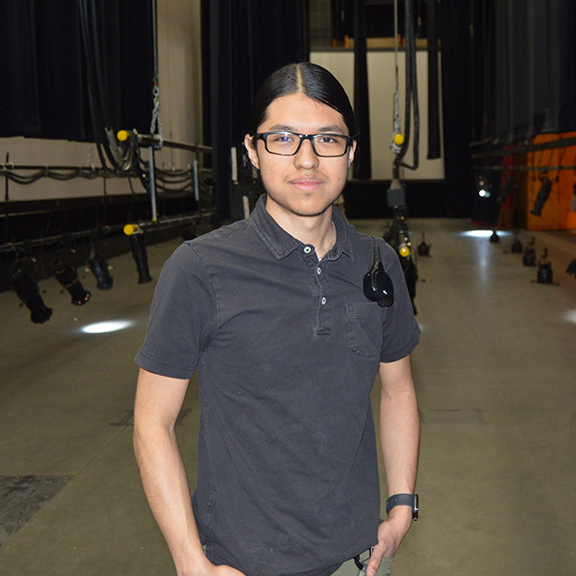
Cheyenne Mendoza, Technical Director, VPAC
PROFESSIONAL PROFILE
| Name: | Cheyenne Mendoza | |
| Profession: | Technical Director | |
| Company: | Vilar Performing Arts Center (VPAC) | |
| Years of Experience: | 7+ years | |
| Hometown: | Leadville, Colorado, USA | |
| Venues: | VPAC, Beaver Creek, Colorado, and | |
Gerald R. Ford Amphitheater, Vail, Colorado | ||
| Industry: | Live Entertainment | |
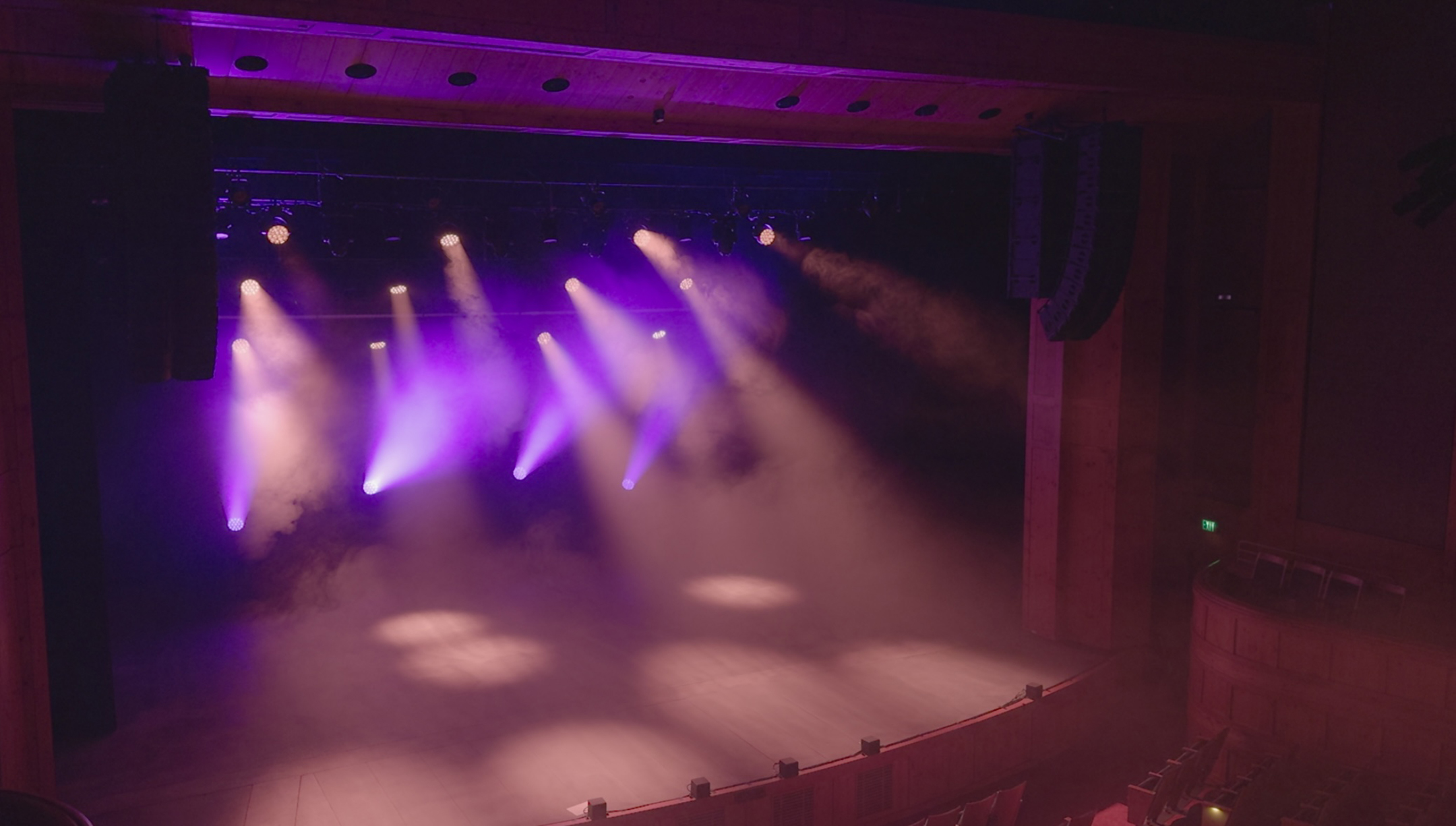
A view of the lighting rig at VPAC. Photo Courtesy of VPAC.
THE INTERVIEW:
City Theatrical (CT): How long have you been working at the VPAC?
Cheyenne Mendoza (CM): I started working at the VPAC as a stagehand in Fall 2017, then worked in Audio before transitioning into my role as Technical Director. All of my training up until that point was pretty much exclusively audio. My mentor was the Technical Director of the Bravo! Vail Music Festival, and he's the one who introduced me to the VPAC. I've lived in and around the Vail Valley in Colorado my whole life, I didn't even know that this place existed before he introduced me to it. He brought me in, and I slowly worked my way up the chain. I have enjoyed working here tremendously.
Then the pandemic hit and everything shut down for a while, this place persisted in presenting concerts in live stream format, which I was fortunate to be a part of and continue working during that difficult time for the world, and especially live entertainment. During that time, I was doing work as a Video Director, Camera Operator, and roles like that for live stream. After that period of transition, operations were starting to boost back up. The VPAC was looking for a Technical Director, so I put my hat in the ring and gave it a shot. I knew audio very well. I know video somewhat well. While I knew lighting was my weakness, I was confident that I could grow.
I got the job, and, over the last three seasons, it's been a constant learning process. I feel I have made a good progress and surrounded myself with very knowledgeable people. My technicians and designers are good people to be around. They always share knowledge and we’re always trying to keep up with the latest industry trends and making sure that we know about the latest, greatest things, and understand best how to integrate them into our workflow.
CT: What do you like doing best as a Technical Director?
CM: I enjoy designing shows and planning improvements. With solo classical shows, like the Ray Chen, violin performance we hosted in March 2024, it’s simple to take the easy path when lighting for classical shows but there is still a lot of room for creativity. We paint the shells with light and try to make it a beautiful experience for the audience. Combining various systems of washes, specials and accent lights are all really goodtools to use for this type of show. But at the heart of it... I'm still an audio guy. I was just working on an installation at our sister venue, the Gerald R. Ford Amphitheater in Vail, Colorado, where we're putting in a new sound system for the lawn, GA section, which will soon be followed by a substantial installation for the pavilion section. I enjoy working on all technical and creative aspects of audio, video, and lighting, I suppose.
I love the design and planning aspect for new production upgrades. Our most recent investment was in 16 GLP X5 fixtures in 2023, which was the reason we were at LDI Show 2023. Our main goal was sure to go, experience new technologies, and meet other industry professionals. We had the choice between this and three other fixtures from a couple of other manufacturers. We went to the GLP booth and found that the X5 fixture fit the current needs of our theater perfectly.
CT: How are the GLP X5s working for you in your space?
CM: Very well! Initially, our previous moving head wash system consisted of half the amount of fixtures we have now. Those fixtures have been installed at the front of house to provide us with a bit more flexibility. Having an LED front Wash has allowed us to increase our capabilities. Our most recent addition of the 16 GLP X5s has allowed us to split the rig across three electrics, allowing us to create more depth to the stage. It used to be just the two electrics, where everything was very tightly clustered around two pipes. Being able to expand the rig and push a little further downstage and a little further upstage has allowed us to make room and have the stage feel a little bigger than it actually is.
CT: Does this season look different than last, based on the addition of those fixtures?
CM: It does. A big reason we invested in the GLP X5 was that the new light engine that GLP developed, which is RGB + L instead of the traditional RGB or RBG + W. Our old fixtures were RGBW which lends itself very well to some very nice pastels but limits the precision of your hue. The “Lime” emitter, which looks like a sickly yellow on its own, in conjunction with all the other emitters contributes to a nice, fuller spectrum of white.
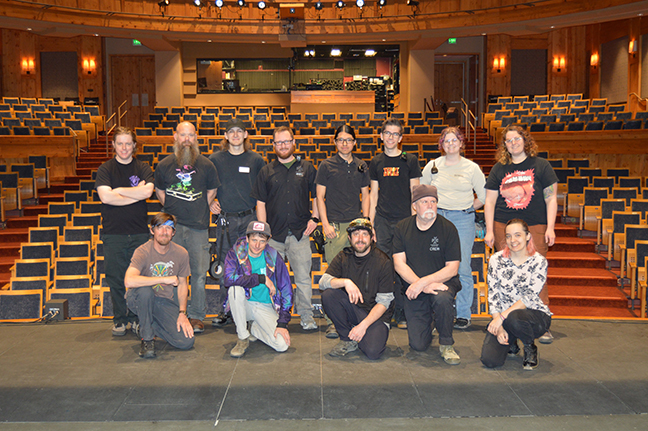
The backstage team at the VPAC. Photo credit: City Theatrical.
CT: Can you tell us more about how you use the RGB + L fixtures?
CM: Sure, with RGB + Lime, you essentially have very precise control over the hue. You have the ability to choose very subtle hues or very saturated colors. The 16-bit dimming and color mixing performance on these fixtures allows for very precise and consistent fades. We got them in and their first big show was Alonzo King LINES Ballet. Their lighting was very precise, and these fixtures had a very big role to fill.
We’re approaching the point where many LEDs are starting to look comparable or almost indistinguishable from Tungsten. These fixtures are incredibly useful lights, not just for theater, but also for classical, ballet and dance performances. They are also incredibly useful lights for Rock and Roll shows. They have an immense zoom range, are incredibly fast, and have been reliable and precise. They have been very well received from both the concert and classical designers.
CT: How do you work with lighting designers who come into the VPAC to work on different performances?
CM: We sit in a very interesting place, in which our artistic team is always trying to book shows that are well above what is typical in a 500-seat theater. A lot of our bookings are beyond what our audiences would expect to see in such a small space, yet here they are at the Vilar Performing Arts Center, as many shows have only ever seen in much larger venues.
Larger shows always bring their own designers, consoles, and occasionally their own lighting package, but when offers are made under the agreement of 'house sound and lighting', bolstering our rig has allowed us to minimize rentals and meet as many riders as possible with in house equipment.
CT: For a classical performance, what kinds of lighting are you using?
CM: For classical, in general, we use as little LED as possible, because the room is so quiet. You can hear a pin drop backstage from the balcony. Even though all our lights have modes to be able to run quietly or with low fan speeds for classical, we try to make a point to only use Tungsten and conventional lights for the performances, especially in the environment that we’re in - we don’t have super high trims available here and performers are very sensitive to the fan noise.
Otherwise, I set up a very basic system of PARs for a base white wash. Then we move to lighting the scenery and with classical we have the orchestra shells, which we have set up at our mid-stage traveler line. For classical, it’s always a mixed bag, but they normally don’t want anything flashy. We try to design something that makes the musician(s) pop, introduces a little bit of design, and makes the setting feel a little more interesting. We keep the house lights on at about 10-15% so that our patrons can read their programs during the performance. It feels very intimate, too, to be on stage and be able to make eye contact with a person in the audience.
If there is a pianist, we light to the detail of seeing his fingers play. To provide the texture on the shells, we use ETC Source Fours, two on each side, each with the standard, medium leaf breakup gobo inside of them, and a City Theatrical Top Hat, so the audience doesn’t see the light from the fixture itself. The Top Hats do their job well, and the gobos skim across the surface of the shelves, which really helps add visual interest.
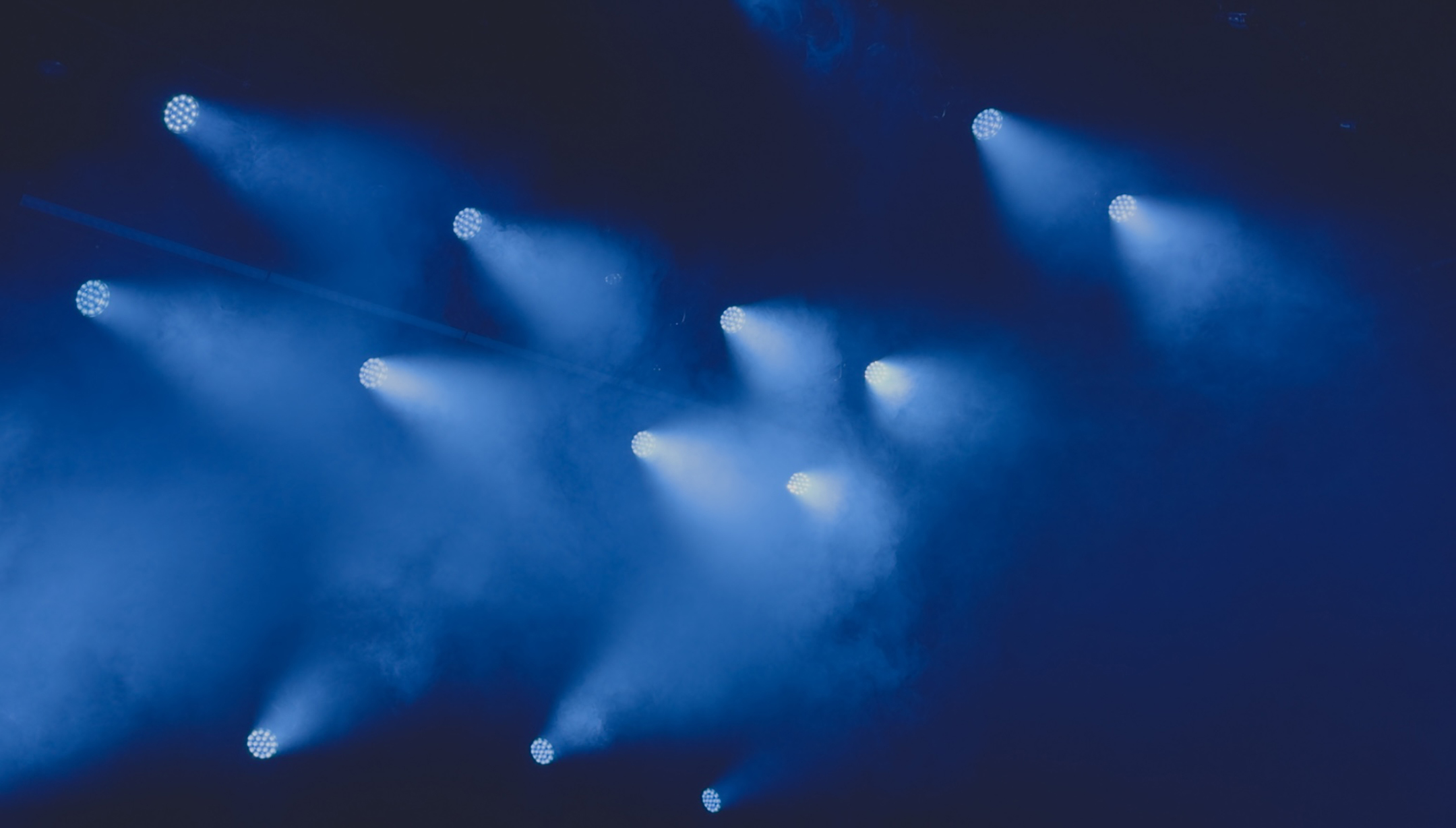
GLP X5 Fixtures with City Theatrical beam control accessories at VPAC. Photo Courtesy of VPAC.
CT: Do you use any lighting techniques to enhance the performer's skin tone?
CM: As Tungsten varies in intensity, you get a difference in color temperature. By varying the intensity between various systems all aimed at the same subject you can create variations between warm and cool tones which can enhance a performer’s skin tone.
The shells lend themselves extraordinarily well to selecting color with intensity, too. You can cover the whole wall with one fixture and crank the intensity to make a very stark, white appearance. Add more fixtures and bring down the intensity and you get a very warm hue on the wood.
CT: Do you ever use elaborate scenery for any of the performances that come in, or is it mostly the shelves and other lighting effects?
CM: We don't usually. We're almost exclusively a Roadhouse. We don't produce almost any of the shows that we have.
We have two exceptions to that rule, every year in the spring and in the winter, we have a local youth ballet company that rents out the space. They work with my lighting designers and audio engineers to produce their shows.
CT: How is your pre-hang for a dance performance different from a classical performance?
CM: For the design of a classical musician’s performance, the lighting plot is conceived before the musician(s) get here. We think about where the shells are going to be placed and have them (the musicians) decide where they want on stage. We generally know the needs of the artist and then we work around it to add visual interest where we can.
When we're working with an established dance company, such as BODYTRAFFIC, which also performed at the VPAC in March 2024, they have their own lighting designer who wants to make sure the pieces that are designed in their space look the same wherever they go anywhere in the world. When we're hanging their plot, we get the lighting paperwork ahead of time. They look at our existing inventory, which thankfully we've been able to cover 90% of the things that come through here without the need for any substantial rentals. As we continue to invest in the theater, we'll be able to eventually get to the point where we have zero rentals, and we'll hang to their exact specifications.
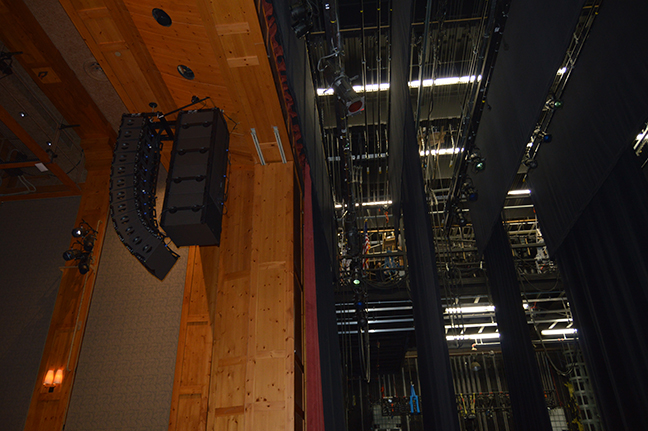
GLP X5 Fixtures with City Theatrical beam control accessories backstage at VPAC. Photo credit: City Theatrical.
CT: How are the GLP® Accessories, including our Top Hats, working out?
CM: Your GLP Top Hats are awesome. They're great, especially with these zoom lenses, because they spill without using a Top Hat. It is super helpful to have. The X5 Concentric Rings are also working out great. We sat in the audience of a performance last night, and looked for the lights, but we didn't see anything. They did their job! I was happy to see that the GLP Accessories are working so well.
CT: Tell us more about your role and your team - how do you work together?
CM: Currently I lead both production departments. Whenever we have video involved, then they will also work with me.
Our Production Manager Shane Huebner and I will work together to advance upcoming shows and for major productions like dance, that require a lot of precision and attention to detail we’ll have a master electrician and a team of electricians that will hang and focus the designer’s plot. When working with precise and detail-oriented designers it can be a very stressful job for whoever is in the air focusing the lights, but the end result is highly rewarding.
It is often hard to find talent in the mountains or try to get talent to relocate in the mountains. We are very lucky to have the team we have assembled. We appreciate their loyalty and talents very much.
CT: How many shows are you currently running per week? Is it more during the ski season?
CM: I would say we book some big shows during the summer season, but not many or as often as in the winter, which can be four or five shows in a week.
Shane Huebner and I also manage performances at the Gerald R. Ford Amphitheater (GRFA), so our roles are split between both venues. The GRFA opens during the first weekend of April, so we are especially busy there during the warmer summer months. This outdoor amphitheater is just 15 minutes West of us in Vail. It’s a very different performance space, as a 2,500-seat capacity outdoor amphitheater, which was initially designed for classical music. In recent years, we’ve started booking bigger concerts as well as hosting classical music and the VVF’s own Vail Dance Festival.
CT: Can you tell us more about the upcoming Vail Dance Festival?
CM: Sure, the Vail Dance Festival happens annually. The bulk of the festival happens at the GRFA and then we’ll host two or three performances that are better suited to our space here at the VPAC. The GRFA doesn’t have wings, a grid or a fly system so it is an incredible effort to create all that to host dance performances in the outdoor space.
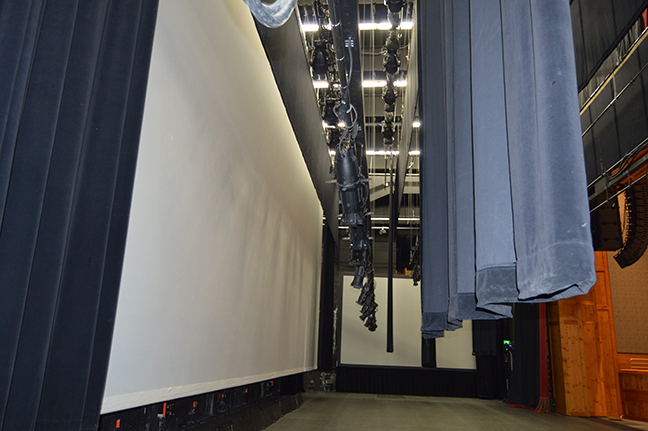
Backstage at VPAC. Photo credit: City Theatrical.
CT: What lighting software are you using?
CM: We use Vectorworks in house. We have a couple of Vectorworks licenses that we share, and then most designers send us files. We also use Lightwright 6 in conjunction with that, as it helps us produce most of the necessary paperwork, with all the necessary information. We also use Moving Light Assistant™ software. I'm always up for looking to see what the latest and greatest software solution is.
CT: Do you use a DMXcat® Multi Function Test Tool?
CM: We do! I have one and love it. My designers and I always have one in our back pockets.
It’s an exceptional troubleshooting and testing tool. Its RDM controller allows us to make edits to devices when the rig is already in the air and its ability to read and display DMX values makes it a very quick way to settle debates, verify connectivity and get things done quickly.
CT: Is everything here wired? You said RDM - are you using wireless DMX/RDM at all?
CM: We don’t use any wireless, although we’re looking into it. Our May Gallery space is perfect to present more intimate shows but it isn’t currently designed to be a performance space, more of a lounge. We recently hosted a comedian and built a couple of riser decks with a very small PA. We made it work, but it was very cumbersome. We took a couple of our movers from stage and used them there. There are no real positions for lights and especially having so much cable, and it is less than ideal for the audience experience if there’s a cable ramp on your way to the bathroom. It would be an ideal space for a simple Multiverse® SHoW Baby® setup.
We're looking at a couple of products that have the City Theatrical Multiverse wireless DMX/RDM already built into them for our main stage, and will start to develop a package next year. There are a couple of up lights up there that already have wireless DMX modules built into them, that are battery operated no less. It will be interesting to see how wireless DMX changes the way we do lighting across our various spaces.
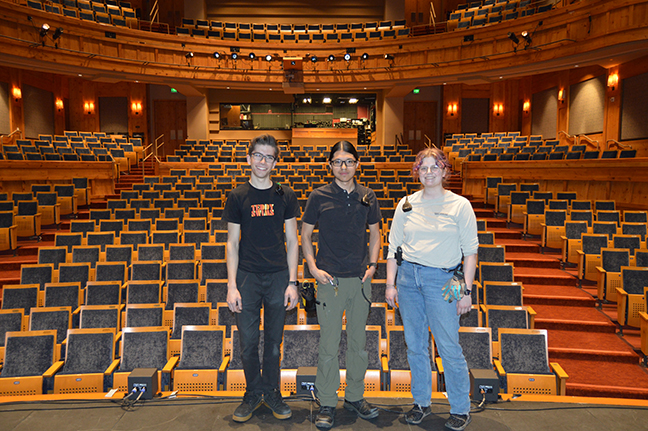
The lighting team at VPAC, including Riley Goossen (left) and Cheyenne Mendoza (center). Photo Credit: City Theatrical.
CT: Other than the GLP X5 Accessories and DMXcat that we already discussed, which other City Theatrical products do you use?
CM: If we need a top hat of any kind, we're buying a City Theatrical Top Hat.
If we need an Iris, we're buying a City Theatrical DMX Iris or Drop-In Iris.
Whatever niche rigging solution we need for a particular deployment, City Theatrical already made it or will make it custom. We appreciate that.
We also use Safer Sidearms™, Track Tamers™, and Pipe End Tail Downs. The Junior Safer Sidearm hangs on our rep box room positions and many of the larger steel sidearm live on the front of the catwalk. We have an inventory of Pipe End Tail Downs that can be deployed when necessary.
I, of course, must mention the Blacktak™ Light Mask Foil that always makes an appearance whenever we really need to make the rig invisible.
For more information about Cheyenne Mendoza and upcoming shows at VPAC, visit: https://vilarpac.org/
Products Used:
Want to read this designer interview in print?
View or download this interview as a multi-page PDF.
Download Interview PDF
